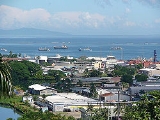
Suva
Overview
Tropical rainforest climate
A tropical rainforest climate, also known as an equatorial climate, is a tropical climate usually found along the equator...
under the Koppen climate classification
Köppen climate classification
The Köppen climate classification is one of the most widely used climate classification systems. It was first published by Crimea German climatologist Wladimir Köppen in 1884, with several later modifications by Köppen himself, notably in 1918 and 1936...
. The city sees a copious amount of precipitation during the course of the year. Suva averages 3,000 mm of precipitation annually with its driest month, July averaging 125 mm of rain per year. In fact, during all 12 months of the year, Suva receives substantial precipitation. Like many other cities with a tropical rainforest climate, temperatures are relatively constant throughout the year, with an average high of about 28°C and an average low of about 22°C.
Suva is noted for its considerable rainfall, it has a markedly higher rainfall than Nadi
Nadi
Nadi is the third-largest conurbation in Fiji. It is located on the western side of the main island of Viti Levu, and had a population of 42,284 at the most recent census, in 2007. Nadi is multiracial with many of its inhabitants Indian or Fijian, along with a large transient population of foreign...
and the western side of Viti Levu
Viti Levu
Viti Levu is the largest island in the Republic of Fiji, the site of the nation's capital, Suva, and home to a large majority of Fiji's population.- Geography and economy :...
, which is known to Suva citizens as "the burning west".
Unanswered Questions

